Sierentz County - Bartenheim
|
Town hall of Bartenheim 9, rue Général de Gaulle 68870 Bartenheim |
Phone: 03.89.70.76.00 Fax: 03.89.70.71.22 www.bartenheim.fr |
||
Opening hours of the secretariat:
|
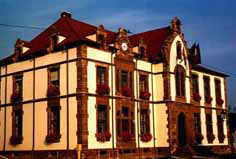 Bartenheim: Town Hall |
|
History The river formerly separated the village into two seigniories of which one concerned the bailliage of Haut-Landser and the other Landenberg. The chapter of the cathedral of Basle held a domanial court there. Behind the war memorial one can see the presbytery of 1747 and the Saint-George church of recent construction after the fire of 1934. It preserves a bell-tower of 13th century at the arched ground floor. |
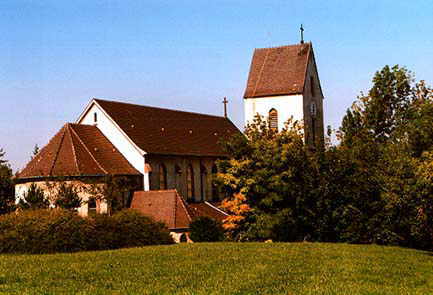 |
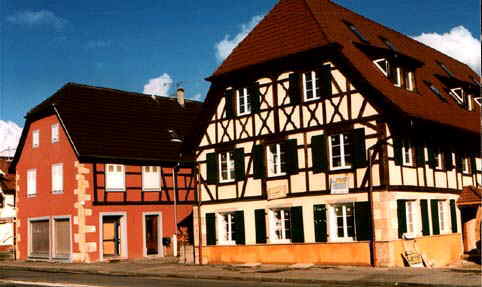
Saint Nicolas's Chapel.
This small sanctuary, formerly located
outside the agglomeration, is quoted from 1521 and some arches
in the chorus date from 1695. A Gothic door frame is still visible
at the roadside.
In the hall, two paintings represent St Aloyse and St Antoine
de Padoue. In the rear of the chapel, there is a beautiful baroque
unit with on the left, an altar dedicated to the 14 saints intercessors
and on the right a beautiful statue of a Virgin to the Child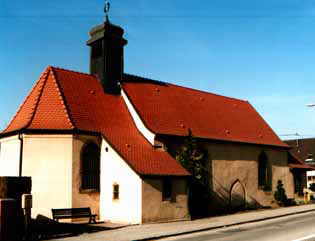 from 1500. The high-alter comprises
a series of sculptures: Saint Michael with the balance of the
last judgment, Saint François d'Assise, Saint Nicholas
bishop, Saint Antony the Hermit with his tau and his small bell,
Saint Raphael and the angel, Saint Barbara with a tower, Saint
John, Saint Catherine with the wheel.
from 1500. The high-alter comprises
a series of sculptures: Saint Michael with the balance of the
last judgment, Saint François d'Assise, Saint Nicholas
bishop, Saint Antony the Hermit with his tau and his small bell,
Saint Raphael and the angel, Saint Barbara with a tower, Saint
John, Saint Catherine with the wheel.
At the wall of the chorus, the statue of holy Genevieve undoubtedly
dates from about 1500 and could be allotted to the author of the
Virgin to the Child referred to above.
In the nave, under the organ loft of 1669, one can see a statue
of Saint Nicholas, on the left a St John the Baptist and opposite
a very realistic baroque Christ .
A legend is attached to the creation of this Christ on the cross
with a tormented and alarming look on his martyr. It appears that,
a little time after the end of the Thirty Year war, an unknown
man knocked on the gate of the cure of Bartenheim. He explained
he came from the south, where the mountains keep their white cover
all the year, that the plague had prevailed and that he was one
of the last survivors of his village. He looked for work as a
sculptor and shelter for the approaching winter. The priest ordered
a Christ on the cross for shelter and subsistence. When he saw
the completed sculpture, the priest had a movement of fear so
terrible was the expression of the martyrised. The artist explained
that he had put in his work all the sufferings, sorrows and afflictions
from which he had suffered; he left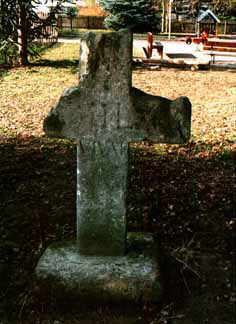 a little afterwards in the direction of Ensisheim; his name remained
unknown, his work remains.
a little afterwards in the direction of Ensisheim; his name remained
unknown, his work remains.
Oldest cross of Sundgau
A little further, about 600 meters on the right
side, in the enclosure of the medico-educational institute, at
the edge of the road, is a small cross. Massive and monolithic,
coarsely carved and worked, it is one of the oldest that one can
see in Sundgau.
It is connected with the expiatory crosses which
one finds in the valley of the Rhine and which were erected from
the 12th to the 15th century to mark the precise place of a murder
or an assassination. No written history exists for this monument
but the popular tradition kept the following narration: a merchant
or a knight came from Blotzheim on horse in the direction of Bartenheim.
In his saddle holsters were much money and gold coins. Close to
this place, he was attacked by some robbers who in spite of his
savage defence threw him down from his horse and inflicted numerous
stab-wounds on him. The horse got into a panic and returned at
a full gallop to Blotzheim with the money coveted by the brigands.
Searches were organised to find the attackers. Three of them were
captured a few days later and were hanged without further ceremony.
Its wear could come from the fact that the peasants,
to protect themselves from the lightning, had the habit of sharpening
their scythes on the horizontal branches of the cross.
Our-lady of the Fields
Close by, left of the road stands a little chapel
quite as mysterious as the reasons for  its
installation. This chapel was erected at the junction of an antique
path, which ran straight through fields, to the pilgrimage of
Our Lady of the Oak in Blotzheim.
its
installation. This chapel was erected at the junction of an antique
path, which ran straight through fields, to the pilgrimage of
Our Lady of the Oak in Blotzheim.
The legend tells that at night this place is not
very secure and that in old times a coach man was killed by a
«fire man ». In truth, 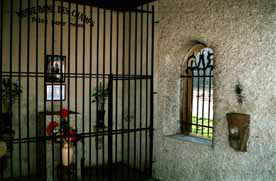 this
chapel could have been erected in 1803 following an assassination
of a " Fuhrmann " (a carter) by a hunter.
this
chapel could have been erected in 1803 following an assassination
of a " Fuhrmann " (a carter) by a hunter.
It sheltered a Christ on the cross, statues of
the Blessed Virgin and Saint John, of a popular art type, which
one can still admire in the church Saint Martin de Bartenheim-la-Chaussée.
The chapel still contains a statue of the Blessed
Virgin put there in 1982 and which gave it its name.
Official
Website from Bartenheim: www.bartenheim.fr

Services:
Railway Station SNCF, Post Office,
bank, fire station,...
Market on the main place friday morning
Association La
Clef / Maison Pour Tous
Restaurants:
Hôtel-Restaurant
Koenig -
Au Lion Rouge
(Tel 03.89.68.30.29)